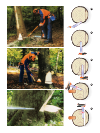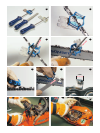
The best working height is when the
trunk is at hip height. Stand on the left
of the trunk and work from the base of the
tree upwards. Stand firmly, with your feet
apart and keep the saw close to your body.
Work with both a pulling and a pushing
chain and always try to rest the saw on the
trunk or against your hip. Only move
when you have the trunk between yourself
and the bar of the saw (1).
Branches on the upper side of the
trunk can be cut with the saw lying on its
side (2). You can limb the branches on the
underside of the trunk at the same time as
the rest if you have a good working height.
Observe how the branches are tensioned,
so you can saw them from the correct
side, otherwise, there is a risk that the saw
will get caught. If the tree is lying right
on the ground, you’ll have to wait with
the branches on the bottom until you’re
finished with the others and can roll the
trunk over. Be careful when the trunk is
close to the ground, since there is quite a
risk that you’ll touch something with the
tip of the bar, which will cause a kickback.
Limbing large branches
If the tree has thick branches, you should
first remove other branches that are in the
way. Since thick branches can be under
Limbing and crosscutting.
It’s easy to get kickbacks when limbing and crosscutting. That’s why you should work calmly and
methodically, and take care not to touch anything with the upper part of the bar nose.
pressure comes from below, you work the
other way around. Start by sawing from
underneath, about one third of the way
through the trunk or until it starts to
pinch the bar (5a). Then cut from above,
to meet the first cut (5b).
If the saw gets stuck
If the bar gets stuck, don’t try to pull
out the saw. Instead, stop the engine and
bend open the trunk until the saw comes
loose. (6)
great tension, limb them in stages from
the end, in towards the trunk.
Saw with the bar held vertically,
to reduce the risk of it getting caught.
If the branch is very thick, you might
have to cut it from two sides. (3)
Crosscutting
Study the tree and your surroundings
before you start, especially if the trunk is
thick. First, try to see how it is tensioned.
Watch how the trunk reacts when you
start to saw. You might have misjudged
the tension.
Stand off to the side of the cut, since
the trunk can jump up when it comes
apart. Never stand below the trunk if the
ground is sloping.
Pressure on the top
If the trunk lies so that the pressure
comes from above, start with a cut from
above. Saw about one third of the way
through the trunk or until it starts to
pinch the bar (4a).
Then cut from underneath, to meet
the first cut (4b).
Pressure on the bottom
If instead the trunk lies so that the
1 2


















